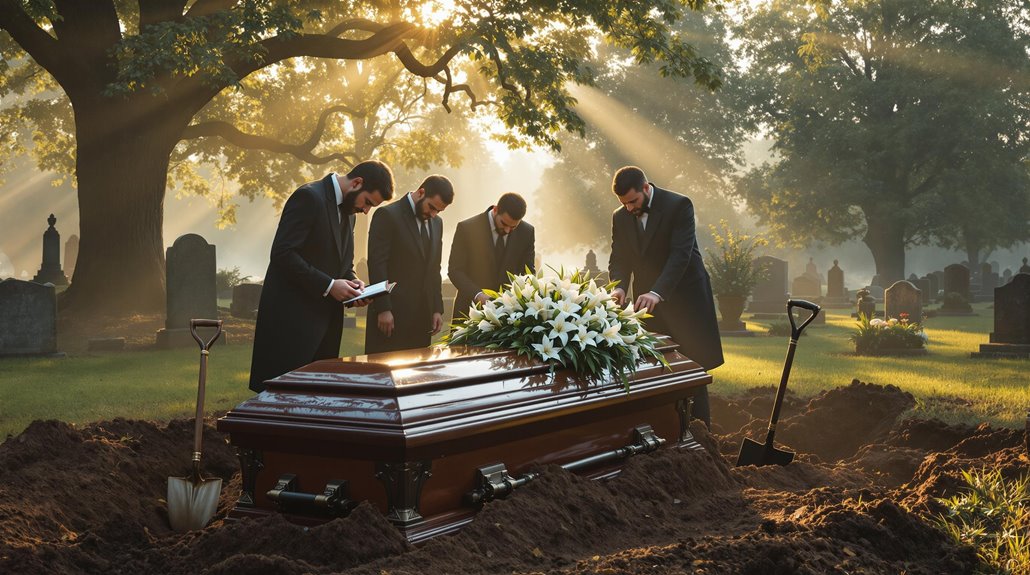When my grandmother passed away last spring, our family honored her love of gardening by planting her favorite roses around her grave and sharing seedlings from her garden with funeral guests. I’ve discovered that showing love through burial customs goes far beyond the somber ceremonies we typically associate with funerals. Through centuries of tradition and modern innovation, communities worldwide have developed deeply meaningful ways to celebrate lives and comfort those left behind.
The Sacred History of Burial Practices

Since the dawn of human civilization, we’ve found meaningful ways to honor our deceased loved ones through carefully planned burial rituals and ceremonies. I find it fascinating how ancient cultures from Egypt to China developed elaborate practices that reflected their deepest beliefs about life, death, and the afterlife.
When I study burial rituals across different societies, I’m struck by how they strengthen ancestral connections through specific customs like preparing the body, selecting meaningful grave goods, and gathering the community.
Today, I see how these time-honored traditions continue to provide comfort and structure during our most difficult moments. From the sacred burial grounds of Native Americans to modern memorial gardens, these practices help us maintain bonds with those who’ve passed while processing our grief in culturally significant ways.
Understanding Modern Funeral Customs
While ancient burial practices laid the foundation, modern funeral customs have evolved to blend time-honored traditions with contemporary preferences and needs. I’ve noticed how funeral attire has shifted from strictly black to more personalized choices, though maintaining respectful tones remains important.
| Modern Custom | Purpose | Common Practice |
|---|---|---|
| Memorial Services | Celebration of Life | Photos, music, stories |
| Viewing/Wake | Family Gathering | Open or closed casket |
| Reception | Community Support | Shared meals, memories |
When I attend memorial services today, I see how they’ve become more personalized celebrations of life rather than solely somber occasions. You’ll find that many families now incorporate multimedia presentations, live music, and meaningful readings that reflect their loved one’s personality and legacy.
Cultural Expressions of Grief and Respect
Throughout different parts of the world, I’ve observed how cultural traditions shape the ways people express their grief and show respect for the deceased. As I’ve traveled and studied various grief rituals, I’ve discovered the profound ways different societies honor their loved ones who’ve passed.
- In Mexico, families celebrate Día de los Muertos with colorful memorial symbols and altars filled with photos and favorite foods.
- Japanese Buddhist families maintain butsudan shrines at home, offering daily prayers and incense to ancestral spirits.
- Many African cultures practice extended mourning periods with specific clothing colors and community gatherings.
- Irish wakes traditionally combine storytelling and celebration of the deceased’s life.
- Native American tribes often incorporate sacred ceremonies with drumming and smudging rituals that honor the spirit’s journey.
These diverse expressions remind us that there’s no single “right way” to show our love and respect.
Ethical Considerations in End-of-Life Care

As medical professionals face increasingly complex decisions around end-of-life care, I’ve observed how ethical principles must carefully balance patient autonomy with clinical responsibility.
When you’re dealing with end-of-life situations, it’s vital to understand how autonomy rights protect a patient’s choices about their final days.
I’ve seen firsthand how dignity preservation becomes a top priority in hospitals, hospices, and nursing homes across America. Medical teams work diligently to honor both the patient’s wishes and their family’s cultural practices, while maintaining professional standards of care.
You’ll find that most facilities now offer advanced directive planning, family counseling services, and dedicated staff who specialize in palliative care. The goal is to guarantee that every person receives compassionate treatment that respects their values, beliefs, and personal choices until the very end.
Creating Meaningful Memorial Traditions
Since loved ones continue living in our memories long after they’re gone, I believe creating meaningful memorial traditions helps us maintain those precious connections.
Through memorial rituals and remembrance ceremonies, I’ve discovered beautiful ways to honor those who’ve passed while helping my heart heal.
Here are some meaningful traditions you can start:
- Create a memory book filled with photos, letters, and cherished stories to share with family
- Plant a memorial garden that blooms with their favorite flowers each spring
- Hold annual gatherings where loved ones share memories over their favorite meals
- Light a special candle on important dates while reflecting on happy times together
- Visit meaningful places you shared, leaving small tokens of remembrance like stones or flowers







